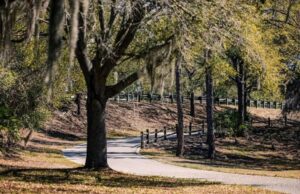Orange County Government has received multiple awards for its environmentally conscious efforts to preserve more trees around development sites and increase the county’s urban canopy.
The Florida Urban Forestry Council and the Arbor Day Foundation recognized an ordinance the County Commission approved on September 12, 2023. The ordinance takes effect on March 15, 2024, and will have its greatest impact on development projects, by protecting more trees during construction activities, promoting tree species diversity, and updating mitigation requirements.
 The public is invited to ask questions and learn more about the ordinance during a Customer-First informational webinar scheduled for Thursday, March 21, 2024, at 2:30pm. Registration is available online.
The public is invited to ask questions and learn more about the ordinance during a Customer-First informational webinar scheduled for Thursday, March 21, 2024, at 2:30pm. Registration is available online.
The Florida Urban Forestry Council will recognize Orange County with the “Outstanding Ordinance” award during a presentation later this month.
In addition, the County won the Tree City USA Growth Award presented by the Arbor Day Foundation. The Arbor Day Foundation is the world’s largest nonprofit organization dedicated to planting trees.
“The awards recognize the County’s commitment to the increased protection of existing healthy trees for new development and redevelopment,” said Ted Kozak, Chief Planner with the County’s Zoning Division.
Orange County began the process of updating its 23-year-old tree preservation and removal ordinance in 2021 with input from stakeholders including developers, landscape architects, and environmental advocates.
The ordinance provides additional regulatory protections during the development process to Specimen trees identified by minimum threshold diameter at breast height (DBH), such as Winged Elm, Turkey Oak, Longleaf Pine, Sweetgum, and Bald Cypress, and to Heritage trees identified by an even larger minimum threshold DBH for Live Oak and Southern Magnolia trees.
The ordinance gives developers stricter guidelines for tree preservation by limiting the removal of Heritage trees and Specimen trees in parking lots, open spaces, residential subdivisions, and near stormwater ponds. The ordinance also places a greater emphasis on tree mitigation, requiring that developers replace the tree canopy at a 3:1 ratio for every inch of Specimen tree removed and a 5:1 ratio for every inch of Heritage tree removed.
“Protection and preservation of trees is critical for our future,” said Alan Marshall, Assistant to the Director of the County’s Planning, Environmental and Development Services Department. “Everyone benefits from a healthy tree canopy. Our county’s urban forest must be properly managed to develop a diversity of species. When developers plan sites, they need to minimize impacts to trees and maximize preservation.”


